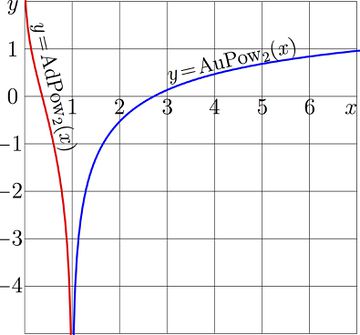Difference between revisions of "AdPow"
m (Text replacement - "\$([^\$]+)\$" to "\\(\1\\)") |
|||
| Line 1: | Line 1: | ||
[[File:AuPow2Plot.jpg|360px|thumb|Fig.1. |
[[File:AuPow2Plot.jpg|360px|thumb|Fig.1. |
||
| − | + | \(y\!=\!\mathrm{AdPow}_2(x)\) and |
|
| − | + | \(y\!=\!\mathrm{AuPow}_2(x)\) ]] |
|
| − | [[File:Adpow2map.jpg|360px|thumb|Fig.2. |
+ | [[File:Adpow2map.jpg|360px|thumb|Fig.2. \(u\!+\!\mathrm i v\!=\!\mathrm{AdPow}_2(x\!+\!\mathrm i y)\)]] |
[[AdPow]] is specific [[Abelpower]] function, id est, the specific [[Abel function]] for the [[Power function]]. |
[[AdPow]] is specific [[Abelpower]] function, id est, the specific [[Abel function]] for the [[Power function]]. |
||
| Line 9: | Line 9: | ||
[[AdPow]] can be expressed as elementary function, |
[[AdPow]] can be expressed as elementary function, |
||
| − | + | \(\mathrm{AdPow}_a(z)=\log_a(\ln(1/z))\) |
|
| − | Where |
+ | Where \(a\) is parameter. Usually, it is assumed that \(a\!>\!0\). |
[[AdPow]] is [[inverse function]] of [[SdPow]], that, in its turn, is [[superfunction]] of the [[power function]]. |
[[AdPow]] is [[inverse function]] of [[SdPow]], that, in its turn, is [[superfunction]] of the [[power function]]. |
||
| Line 19: | Line 19: | ||
Another [[abelfunction]] for the power function is called [[AuPow]]; |
Another [[abelfunction]] for the power function is called [[AuPow]]; |
||
| − | + | \(\mathrm{AdPow}_a(z)=\log_a(\ln(z))\) |
|
[[AdPow]] is related with [[AuPow]] function with simple relation: |
[[AdPow]] is related with [[AuPow]] function with simple relation: |
||
| − | + | \(\mathrm{AdPow}_a(z)=\mathrm{AuPow}_a(1/z)\) |
|
| − | For |
+ | For \(a\!=\!2\), both functions [[AdPow]] and [[AuPow]] are shown in Fig.1 |
| − | For the same |
+ | For the same \(a\!=\!2\), [[complex map]] of function [[AdPow]] is shown in Fig.2. |
== [[Inverse function]] == |
== [[Inverse function]] == |
||
| Line 33: | Line 33: | ||
For [[AdPow]], the [[inverse function]] is [[SdPow]], that is [[superpower]] function, id est, [[superfunction]] of the [[power function]]: |
For [[AdPow]], the [[inverse function]] is [[SdPow]], that is [[superpower]] function, id est, [[superfunction]] of the [[power function]]: |
||
| − | + | \(\mathrm{AdPow}_a=\mathrm{SdPow}_a^{-1}\) |
|
[[SdPow]] satisfies the [[Transfer equation]] |
[[SdPow]] satisfies the [[Transfer equation]] |
||
| − | + | \(\mathrm{SdPow}_a(z\!+\!1)=\mathrm{SdPow}_a(z)^a\) |
|
[[SdPow]] is elementary function, |
[[SdPow]] is elementary function, |
||
| − | + | \(\mathrm{SdPow}_a(z)= \exp(-a^z)\) |
|
==Applications== |
==Applications== |
||
Latest revision as of 18:43, 30 July 2019
AdPow is specific Abelpower function, id est, the specific Abel function for the Power function.
AdPow can be expressed as elementary function,
\(\mathrm{AdPow}_a(z)=\log_a(\ln(1/z))\)
Where \(a\) is parameter. Usually, it is assumed that \(a\!>\!0\).
AdPow is inverse function of SdPow, that, in its turn, is superfunction of the power function.
AdPow and AuPow
Another abelfunction for the power function is called AuPow;
\(\mathrm{AdPow}_a(z)=\log_a(\ln(z))\)
AdPow is related with AuPow function with simple relation:
\(\mathrm{AdPow}_a(z)=\mathrm{AuPow}_a(1/z)\)
For \(a\!=\!2\), both functions AdPow and AuPow are shown in Fig.1
For the same \(a\!=\!2\), complex map of function AdPow is shown in Fig.2.
Inverse function
For AdPow, the inverse function is SdPow, that is superpower function, id est, superfunction of the power function:
\(\mathrm{AdPow}_a=\mathrm{SdPow}_a^{-1}\)
SdPow satisfies the Transfer equation
\(\mathrm{SdPow}_a(z\!+\!1)=\mathrm{SdPow}_a(z)^a\)
SdPow is elementary function,
\(\mathrm{SdPow}_a(z)= \exp(-a^z)\)
Applications
AdPow appears as example of the Abel function that can be expressed as elementary function. This allows to trace evaluation of superfunction through the regular iteration; the fixed point unity can be used for the calculation.
References
Keywords
Abel function AdPow Abel function Elementary function Power function SdPow Superfunctions SdPow Superfunctions

